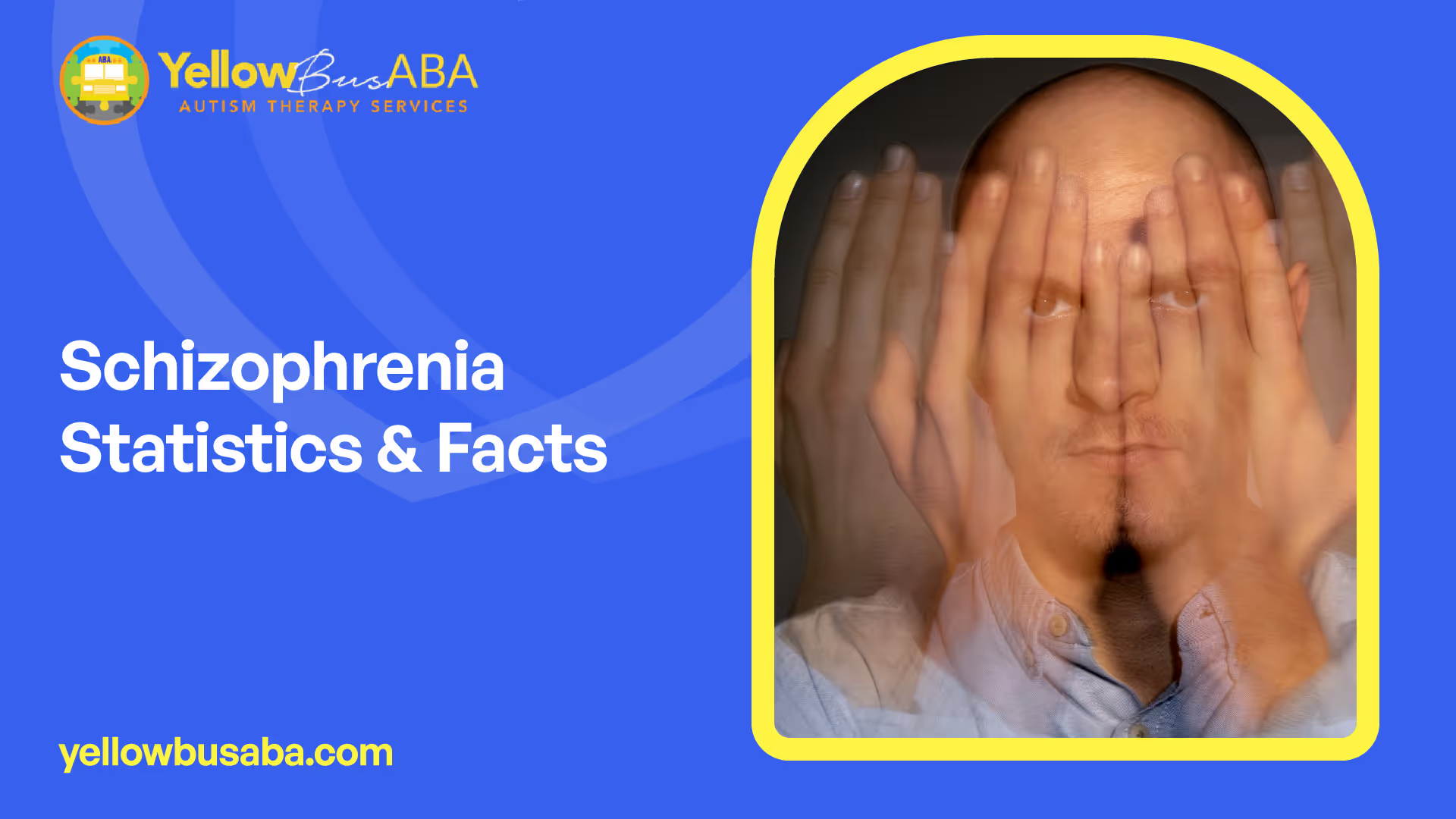Schizophrenia Statistics & Facts
March 5, 2025
Discover essential schizophrenia statistics & facts, including prevalence, risk factors, and global health impacts.

Understanding Schizophrenia

Definition and Overview
Schizophrenia is a chronic and severe mental disorder that affects how a person thinks, feels, and behaves. Individuals with schizophrenia may experience distorted thinking, perceptions, emotions, language, and sense of self. This condition can lead to significant impairments in daily functioning and quality of life.
Symptoms of schizophrenia are typically categorized into three groups: positive symptoms (hallucinations, delusions), negative symptoms (lack of motivation, social withdrawal), and cognitive symptoms (difficulty concentrating, memory issues). The onset of schizophrenia usually occurs in late adolescence or early adulthood, although it can appear later in life.
Risk Factors Associated with Schizophrenia
Various risk factors contribute to the development of schizophrenia. Understanding these factors can help in identifying those at higher risk and implementing preventive measures.
Risk FactorOdds RatioLower occupational status of fathers1.29Poorer residential area socioeconomic status (SES)1.26
Research indicates that both individual and community socioeconomic status at birth are associated with an increased risk of developing schizophrenia. Factors such as social deprivation of parents and neighborhoods significantly contribute to this risk [1].
Additionally, psychosocial aspects play an important role in the occurrence and management of schizophrenia. Important variables include education, occupation, pregnancy, and marital status. Childhood abuse has been noted as particularly influential, with studies showing a stronger correlation with the development of schizophrenia and an earlier onset in women compared to men.
By recognizing these risk factors, healthcare providers can better understand the complexities of schizophrenia and work toward effective strategies for prevention and early intervention. For more insights into mental health conditions, explore our article on mental illness & mental health statistics worldwide.
Global Statistics
Prevalence of Schizophrenia Worldwide
Schizophrenia affects approximately 24 million people globally, equating to about 1 in 300 individuals, or 0.32% of the population. Among adults, the prevalence is higher, at about 1 in 222 individuals, or 0.45%. The global age-standardized point prevalence of schizophrenia in 2016 was estimated to be 0.28%, with no significant differences observed between sexes. The prevalence rates did not vary widely across different countries or regions.
YearEstimated Cases (Millions)199013.1 (95% UI: 11.6–14.8)201620.9 (95% UI: 18.5–23.4)
The number of new cases reported each year is about 1.5 per 10,000 people. Symptoms of schizophrenia typically begin in late adolescence or the twenties, with men often experiencing symptoms earlier than women.
Burden of Schizophrenia on Global Health
Schizophrenia contributes significantly to the global health burden, particularly in terms of disability. In 2016, schizophrenia was responsible for approximately 13.4 million years of life lived with disability (YLDs) worldwide, which accounts for 1.7% of the total YLDs globally. This statistic highlights the substantial impact that this mental health disorder has on both individual lives and public health systems.
The burden of schizophrenia not only affects those diagnosed but also extends to families and communities, emphasizing the importance of understanding and addressing mental health issues globally. For more information on mental health, see our article on mental illness & mental health statistics worldwide.
Gender and Age Trends
Understanding the gender and age trends in schizophrenia can provide valuable insights into its prevalence and characteristics. These trends highlight the differences in how the condition affects various demographics.
Gender Disparities in Schizophrenia
Research indicates that schizophrenia occurs more frequently in males than in females, with an incidence rate of 0.87% in men compared to 0.64% in women. This results in an odds ratio of 1.37, suggesting that men are at a higher risk of developing the disorder [1].
The onset of schizophrenia typically occurs earlier in males, occurring approximately 3.2 to 4.1 years sooner than in females. Although men and women are diagnosed with schizophrenia in similar numbers, men often exhibit more severe symptoms. Among schizophrenia patients, males tend to experience more prominent negative symptoms, whereas females may present more affective symptoms, such as depression and emotional instability.
GenderIncidence Rate (%)Male0.87Female0.64
Age Distribution of Schizophrenia Cases
The age distribution of schizophrenia cases reveals distinct patterns for men and women. The prevalence of schizophrenia is notably higher among men under 40 years of age, with peak incidence occurring between 20 and 29 years. In contrast, women exhibit a higher prevalence after the age of 40, with two notable incidence peaks: the first between 20 and 39 years and the second occurring around the perimenopause period.
The data illustrates that while men are more likely to develop schizophrenia at a younger age, women tend to be diagnosed later in life. This delay in diagnosis is often associated with less severe clinical signs in women compared to men.
Age GroupMale Prevalence (%)Female Prevalence (%)<20 yearsLowLow20-29 yearsHighestLower30-39 yearsDecreasingIncreasing40+ yearsLowHighest
These statistics underline the importance of gender and age as significant factors in the diagnosis and experience of schizophrenia. For further information on mental health, visit our section on mental illness & mental health statistics worldwide.

Socioeconomic Factors
Understanding the socioeconomic factors associated with schizophrenia can provide insight into the complexities of this mental health disorder. Both socioeconomic status and psychosocial factors play significant roles in the incidence and management of schizophrenia.
Socioeconomic Status and Schizophrenia
Research indicates that lower socioeconomic status (SES) is linked to an increased risk of developing schizophrenia. Studies have highlighted that the occupational status of fathers and the quality of residential areas contribute to this risk. For instance, lower occupational status has an odds ratio of 1.29, while poorer residential area SES has an odds ratio of 1.26 [1].
Additionally, both individual and community socioeconomic status at birth have been associated with a heightened risk of developing schizophrenia. Social deprivation experienced by parents and neighborhoods has been shown to contribute to the likelihood of this mental illness. Here is a summary of the relationship between socioeconomic status and schizophrenia:
Socioeconomic FactorOdds RatioLower Occupational Status1.29Poor Residential Area SES1.26
People with low SES are also more likely to suffer from other mental health disorders, such as major depressive disorder (MDD), with a reported prevalence of 40% of depressive disorder among patients with schizophrenia.
Psychosocial Factors Influencing Schizophrenia
Psychosocial factors also significantly influence the occurrence and management of schizophrenia. Key factors include education, occupation, pregnancy, and marital status. These elements are closely related to how schizophrenia manifests, the effectiveness of treatment, and the potential for recurrence.
Childhood abuse has been specifically highlighted as a risk factor for developing schizophrenia, particularly affecting women more than men. This association suggests that traumatic experiences in early life can lead to earlier onset and more severe cases of the illness.
Understanding these socioeconomic and psychosocial influences is critical for developing effective prevention and treatment strategies. For additional insights into mental health disorders, you can explore the mental illness & mental health statistics worldwide section.
Cultural and Ethnic Influences
Understanding the cultural and ethnic influences on schizophrenia is crucial for interpreting its prevalence and diagnosis. Variations in cultural beliefs and practices can significantly impact how schizophrenia is perceived and treated across different populations.
Cultural Variations in Schizophrenia
Cultural context plays a significant role in shaping the experience of schizophrenia. Different cultures may have distinct beliefs about the origins and manifestations of the disorder. For example, some cultures may interpret symptoms of schizophrenia as spiritual experiences rather than signs of a mental illness. This perspective can lead to varying approaches to treatment, including reliance on traditional medicine or spiritual interventions.
Research indicates that cultural differences can also affect the types of symptoms experienced. A study found that Westerners tend to report more visual hallucinations, while East Asians may experience different types of hallucinations. This difference is likely due to varying cultural influences on perceptual and attentional processing [7].
Ethnic Disparities in Schizophrenia Diagnosis
Ethnic disparities in the diagnosis of schizophrenia highlight the complexity of how mental health is understood across populations. In the USA, African Americans are five times more likely to be diagnosed with schizophrenia compared to Caucasian Americans, often instead of being diagnosed with less severe mood disorders [7]. This disparity raises concerns about potential biases in the diagnostic process and the impact of stigma surrounding mental health in different communities.
Moreover, studies have shown that immigrants tend to have a higher incidence of schizophrenia compared to native-born individuals. This higher risk is observed not only in first-generation immigrants but also in second-generation individuals. Factors such as discrimination, stress from relocation, and possibly nutritional deficiencies, particularly low levels of vitamin D, may contribute to this increased risk [4].
The relationship between ethnic density and the risk of schizophrenia has also been noted. A British study indicated that a decline in ethnic density correlates with an increased risk of psychosis, suggesting that social context and community support may play a significant role in the mental health outcomes of individuals from various ethnic backgrounds.
This exploration of cultural and ethnic influences emphasizes the importance of considering these factors in understanding schizophrenia statistics & facts. By acknowledging these variations, healthcare providers can work towards more effective and culturally sensitive approaches to diagnosis and treatment. For broader insights on mental health, refer to our article on mental illness & mental health statistics worldwide.

Health Implications
Complications of Untreated Schizophrenia
Untreated schizophrenia can have severe consequences that affect multiple areas of life. Individuals suffering from this mental disorder may face numerous complications, which can lead to a diminished quality of life.
The following table outlines some of the significant complications associated with untreated schizophrenia:
ComplicationDescriptionHomelessnessIndividuals may struggle to maintain stable housing due to the effects of the disorder.UnemploymentDifficulty in holding a job can arise from symptoms that impair functioning and social interactions.PovertyFinancial instability often results from unemployment and high healthcare costs.Social IsolationThe disorder can lead to withdrawal from social circles, resulting in loneliness and further mental health decline.Increased Risk of SuicideThe risk of suicide is notably higher among individuals with untreated schizophrenia. Studies indicate that people with schizophrenia are 2 to 3 times more likely to die early than the general population, often due to physical illnesses.
Prevention and Management Strategies
While there is no definitive way to prevent schizophrenia, certain strategies can help manage symptoms and reduce the risk of complications. Adhering to treatment plans is essential for individuals diagnosed with this disorder. Here are some key approaches:
Understanding the implications of untreated schizophrenia and implementing effective management strategies is crucial for improving the lives of those affected by this complex mental health disorder. For more information on mental health statistics, you can refer to our article on mental illness & mental health statistics worldwide.
References
[2]:
[3]:
[4]:
[5]:
[6]:
[7]:






